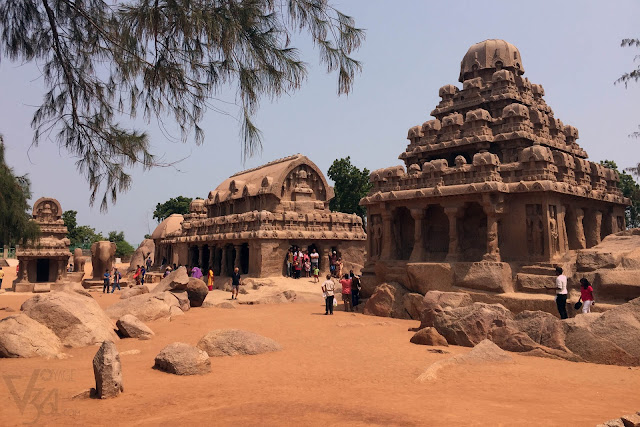The Legacy of
Pallavas, Mahabalipuram-Part I: Rathas
The group of monuments at Mahabalipuram is an UNESCO world
heritage site with its monuments spread across three complex within less than 3 km, with an exception of tiger cave about 5 km north of shore temple. Shore
temple is located at the seashore while the caves are distributed on the nearby
hillock and the Pancha Ratha's about 1 km away. The group of monuments
at Mahabalipuram are built by the Pallava kings between 630 and 728 AD using
local granite rocks.
Apart from the shore Temple, the Pallava period group of monuments at Mahabalipuram are
mostly rock-cut structures in the form of Ratha's or Chariots, Caves/Mantapa's, and bas-relief. All of these can be visited in a
single day with an entire day to spare.
 |
| Pancha Pandava Ratha's/Chariots of Mahabalipuram |
The monolithic structures are named after the Pancha Pandavas of epic Mahabharata, in the order from left to right in the row are the Draupadi Ratha, Arjuna Ratha, Bhima Ratha, Dharmaraja Ratha and Nakula Sahadeva Ratha is built separately. Hence it is sometimes referred to as Pandava Ratha's. There are also monolithic structures of Lion, elephant and bull carved around these Ratha's. The arrangement of these Ratha's in a row looks like a procession.
 |
| Nakula Sahadeva Ratha and the sculpture of elephant |
 |
| Draupadi Ratha (left) and Arjuna Ratha (right) along with monolithic structures of Lion (front) and bull (behind) |
 |
| The massive monolithic rock-cut Bhima Ratha with a base of 12.8 m x 7.3 m and rising to a height of 7.6 m |
 |
| The tallest and largest of the Five Rathas, Dharmaraja Ratha with an height of 11 m and its square base measuring 8.5 m |
 |
| The Five Rathas starting from the left in the pic is Draupadi Ratha, Arjuna Ratha, Bhima Ratha, Dharmaraja Ratha and Nakula Sahadeva Ratha, along with the sculptures of Lion and elephant |
At the nearby hillock near the Descend of the Ganges is another monolithic Ratha, called as the Ganesha Ratha. This monolith rock-cut temple is similar to the ones of Pancha Ratha's in resemblance but is a finished one dedicated to Lord Ganesha.
 |
| Ganesha Ratha, located behind the Arjuna's Penace |
Timings: Sunrise to Sunset, typically 6:00 am to 6:00 pm. It takes about 1 hour to visit each of these Ratha's in detail.
The Legacy of Pallavas, Mahabalipuram-Part II: Caves and Sculptures
The Legacy of Pallavas, Mahabalipuram-Part III: Shore Temple

Comments
Post a Comment